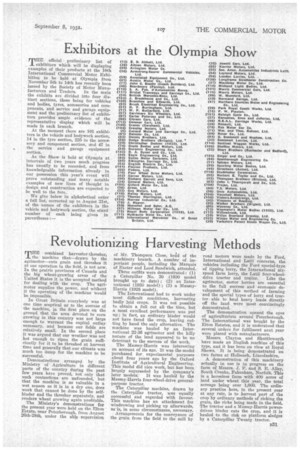Revolutionizing Harvesting Methods
Page 45

If you've noticed an error in this article please click here to report it so we can fix it.
THE combined harvester-thresher, the machine that—drawn by the agrimotor—cuts grain and threshes it at one operation in the field, is not new. In the prairie provinces of Canada and the big wheat-growing areas of the United States it is the acceptedmethod for dealing with the crop. The agrimotor supplies the power, and without it the operating of the machine would be impossible.
In Great Britain everybody was at one time sceptical as to the success of the machine, in the first place on the ground that the area devoted to corn growing in this country was not large enough to warrant the capital outlay necessary, and because our fields are relatively small. In the second place it was argued that our weather was not hot enough to ripen the grain sufficiently for it to be threshed at harvest time and generally that our climate was much too damp for the machine to be successful Demonstrations arranged by the Ministry of Agriculture in different parts of the country during the past few years have proved, not only that such contentions are unfounded, but that the machine is as valuable in a wet season as it is in a dry one, does work that cannot be done by the selfbinder and the thresher separately, and renders wheat growing again profitable.
The Ministry's demonstrations for the present year were held on the Elton Estate, near Peterborough, from August 26th-28th, under the able supervision
of Mr. Thompson Close, head of the machinery branch. A number of important people, including the Marquis of Exeter and Lord Sandwich, attended.
Three outfits were demonstrated: (1) a Caterpillar No. 30 (1930 model brought up to date) ; (2) an International (1930 model) ; (3) a MasseyHarris (1928 model).
The International had to work under most difficult conditions, harvesting badly laid crops. It was not possible to obtain a full cut all the time, but a most excellent performance was put up ; in fact, an ordinary binder would not have faced the crop, leaving cutting by hand the only alternative. The machine was hauled by an International 22-38 agrimotor and the hilly nature of the land appeared to be no deterrent to the success of the work.
The Massey-Harris was interesting on account of its age. It was the model purchased for experimental purposes about four years ago by the Oxford Institute of Agricultural Engineering. This model did nice work, but has been largely superseded by the company's
later models: It was hauled by the Massey-Harris four-wheel-drive generalpurpose tractor.
The Caterpillar machine, drawn by the Caterpillar tractor, was equally successful and regarded with favour. This machine has an attachment for windrowing and picking up afterwards, as is, in some circumstances, necessary.
Arrangements for the conveyance of the grain from the field to the mill by road motors were made by the Ford, International and Latil concerns, the vehicles including the Ford special-type of tipping lorry, the International sixspeed farm lorry, the Latil four-wheel drive tractor and trailer. Like the agrimotor, motor lorries are essential to the full success and economic deelopment of this method of farming and the special types of lorry and tractor able to haul heavy loads directly off the land were most convincingly demonstrated.
The demonstration opened the eyes of agriculturists around Peterborough. The International was bought by the Elton Estates, and it is understood that several orders for fulfilment next year were placed with manufacturers.
Messrs. Clayton and Shuttleworth have made an English machine of this type, and it has been on view at Royal Shows. It is being demonstrated on two farms at Holbeach, Lincolnshire.
A demonstration of this machinery actually in use is in progress on the farm of Messrs. .1. F. and S. E. Alley, South Creake, Fakenham, Norfolk. This is a horseless farm with 400 acres of land under wheat this year, the total acreage being over 1,000. The ordinary practice here, in the present year at any rate, is to harvest part of the crop by ordinary methods of ricking the grain, the ricks being made in the field. The tractor and a Massey-Harris powerdriven binder cats the crop, and it is hauled to the rick on platform sledges by a Caterpillar Twenty tractor.




























































































